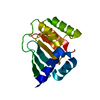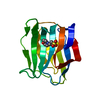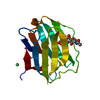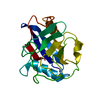[English] 日本語
 Yorodumi
Yorodumi- PDB-2hh8: Solution NMR structure of the ydfO protein from Escherichia coli.... -
+ Open data
Open data
- Basic information
Basic information
| Entry | Database: PDB / ID: 2hh8 | ||||||
|---|---|---|---|---|---|---|---|
| Title | Solution NMR structure of the ydfO protein from Escherichia coli. Northeast Structural Genomics target ER251. | ||||||
 Components Components | Hypothetical protein ydfO | ||||||
 Keywords Keywords | STRUCTURAL GENOMICS / UNKNOWN FUNCTION / ER251 / AutoStructure / NESG / PSI-2 / Northeast Structural Genomics Consortium / Protein Structure Initiative | ||||||
| Function / homology | YdfO-like fold / YdfO-like / Uncharacterised protein DUF1398 / YdfO-like superfamily / Protein of unknown function (DUF1398) / 2-Layer Sandwich / Alpha Beta / Uncharacterized protein YdfO Function and homology information Function and homology information | ||||||
| Biological species |  | ||||||
| Method | SOLUTION NMR / Noesy assignments made with iterative method using CS, 3J, Hyper (dihedral), and Dyana for simulated annealing MD. Converged structures are further refined using NIH-xplor, CNS in explicit water shell (Nielges) . Full lenght sequence was carried through the refinement protocol, the disordered regions, hexHIS tag are not reported. Structure based on 1885 constraints, 788 long range, 142 dihedral constraints, 114 H-bond constraints. | ||||||
 Authors Authors | Rossi, P. / Cort, J.R. / Ho, C.K. / Janjua, H. / Cunningham, K. / Ma, L.-C. / Xiao, R. / Liu, J. / Baran, M. / Swapna, G.V.T. ...Rossi, P. / Cort, J.R. / Ho, C.K. / Janjua, H. / Cunningham, K. / Ma, L.-C. / Xiao, R. / Liu, J. / Baran, M. / Swapna, G.V.T. / Acton, T.B. / Rost, B. / Kennedy, M.A. / Montelione, G.T. / Northeast Structural Genomics Consortium (NESG) | ||||||
 Citation Citation |  Journal: To be Published Journal: To be PublishedTitle: Solution NMR structure of the ydfO protein from Escherichia coli. Northeast Structural Genomics target ER251. Authors: Rossi, P. / Cort, J.R. / Ho, C.K. / Janjua, H. / Cunningham, K. / Ma, L.-C. / Xiao, R. / Liu, J. / Baran, M. / Swapna, G.V.T. / Acton, T.B. / Rost, B. / Kennedy, M.A. / Montelione, G.T. | ||||||
| History |
|
- Structure visualization
Structure visualization
| Structure viewer | Molecule:  Molmil Molmil Jmol/JSmol Jmol/JSmol |
|---|
- Downloads & links
Downloads & links
- Download
Download
| PDBx/mmCIF format |  2hh8.cif.gz 2hh8.cif.gz | 853.9 KB | Display |  PDBx/mmCIF format PDBx/mmCIF format |
|---|---|---|---|---|
| PDB format |  pdb2hh8.ent.gz pdb2hh8.ent.gz | 712.4 KB | Display |  PDB format PDB format |
| PDBx/mmJSON format |  2hh8.json.gz 2hh8.json.gz | Tree view |  PDBx/mmJSON format PDBx/mmJSON format | |
| Others |  Other downloads Other downloads |
-Validation report
| Summary document |  2hh8_validation.pdf.gz 2hh8_validation.pdf.gz | 348.5 KB | Display |  wwPDB validaton report wwPDB validaton report |
|---|---|---|---|---|
| Full document |  2hh8_full_validation.pdf.gz 2hh8_full_validation.pdf.gz | 478.7 KB | Display | |
| Data in XML |  2hh8_validation.xml.gz 2hh8_validation.xml.gz | 37.6 KB | Display | |
| Data in CIF |  2hh8_validation.cif.gz 2hh8_validation.cif.gz | 63.9 KB | Display | |
| Arichive directory |  https://data.pdbj.org/pub/pdb/validation_reports/hh/2hh8 https://data.pdbj.org/pub/pdb/validation_reports/hh/2hh8 ftp://data.pdbj.org/pub/pdb/validation_reports/hh/2hh8 ftp://data.pdbj.org/pub/pdb/validation_reports/hh/2hh8 | HTTPS FTP |
-Related structure data
| Similar structure data | |
|---|---|
| Other databases |
- Links
Links
- Assembly
Assembly
| Deposited unit | 
| |||||||||
|---|---|---|---|---|---|---|---|---|---|---|
| 1 |
| |||||||||
| NMR ensembles |
|
- Components
Components
| #1: Protein | Mass: 18146.715 Da / Num. of mol.: 1 Source method: isolated from a genetically manipulated source Source: (gene. exp.)   |
|---|
-Experimental details
-Experiment
| Experiment | Method: SOLUTION NMR | ||||||||||||||||||||||||||||||||
|---|---|---|---|---|---|---|---|---|---|---|---|---|---|---|---|---|---|---|---|---|---|---|---|---|---|---|---|---|---|---|---|---|---|
| NMR experiment |
| ||||||||||||||||||||||||||||||||
| NMR details | Text: Structure determined by triple resonance NMR spectroscopy. Monomer under NMR conditions. TC = 9.1 +/-0.5 ns (1D T1/T1rho +/- FIT STD). Coordinates reported from residue 7 to 133 based on order ...Text: Structure determined by triple resonance NMR spectroscopy. Monomer under NMR conditions. TC = 9.1 +/-0.5 ns (1D T1/T1rho +/- FIT STD). Coordinates reported from residue 7 to 133 based on order parameter. AutoAssign used for backbone assignment, manually completed sidechain. 13C and 15N NOESY were assigned with AutoStructure. Dihedral angle restraints determined by HYPER . Assignment stats (excluding C-term tag): backbone 96.7%, sidechain 83.7%, aromatic (sc) 79.8%, VL methyl stereospecific 100%, unambiguos sidechain NH2 88.9%. Structure quality factor PSVS 1.3: ordered residues ranges alpha helix (8-22, 26-35, 76-88, 93-102), b-strand (39-43, 48-52, 58-62, 107-111, 116-120, 126-131) [S(phi)+S(psi)]>1.8. RMSD 0.5 bb, 1.1 all heavy atoms. Rama: 87.4% most fav, 12.5% addtl. all., 0.0 gen. all.,0.0% disall. Procheck (psi-phi): -0.17/-0.35 (raw/Z), Procheck (all): -0.15/-0.89 (raw/Z), MolProbity Clash: 24.43/-2.67 (raw/Z) . RPF scores all assigned residues (fit of noesy peaklists to structure): Recall: 0.965, Precision: 0.919, F-measure: 0.942, DP-score: 0.817. L139F cloning mutation of E. coli ydfO gene present. |
- Sample preparation
Sample preparation
| Details |
| ||||||||||||
|---|---|---|---|---|---|---|---|---|---|---|---|---|---|
| Sample conditions | Ionic strength: 0.1 M NaCl / pH: 4.5 / Pressure: atmospheric atm / Temperature: 293 K |
-NMR measurement
| Radiation | Protocol: SINGLE WAVELENGTH / Monochromatic (M) / Laue (L): M | |||||||||||||||||||||||||
|---|---|---|---|---|---|---|---|---|---|---|---|---|---|---|---|---|---|---|---|---|---|---|---|---|---|---|
| Radiation wavelength | Relative weight: 1 | |||||||||||||||||||||||||
| NMR spectrometer |
|
- Processing
Processing
| NMR software |
| ||||||||||||||||||||||||||||||||||||||||||||||||||||||||||||
|---|---|---|---|---|---|---|---|---|---|---|---|---|---|---|---|---|---|---|---|---|---|---|---|---|---|---|---|---|---|---|---|---|---|---|---|---|---|---|---|---|---|---|---|---|---|---|---|---|---|---|---|---|---|---|---|---|---|---|---|---|---|
| Refinement | Method: Noesy assignments made with iterative method using CS, 3J, Hyper (dihedral), and Dyana for simulated annealing MD. Converged structures are further refined using NIH-xplor, CNS in explicit ...Method: Noesy assignments made with iterative method using CS, 3J, Hyper (dihedral), and Dyana for simulated annealing MD. Converged structures are further refined using NIH-xplor, CNS in explicit water shell (Nielges) . Full lenght sequence was carried through the refinement protocol, the disordered regions, hexHIS tag are not reported. Structure based on 1885 constraints, 788 long range, 142 dihedral constraints, 114 H-bond constraints. Software ordinal: 1 | ||||||||||||||||||||||||||||||||||||||||||||||||||||||||||||
| NMR representative | Selection criteria: lowest energy | ||||||||||||||||||||||||||||||||||||||||||||||||||||||||||||
| NMR ensemble | Conformer selection criteria: structures with the lowest energy Conformers calculated total number: 100 / Conformers submitted total number: 20 |
 Movie
Movie Controller
Controller












 PDBj
PDBj HSQC
HSQC